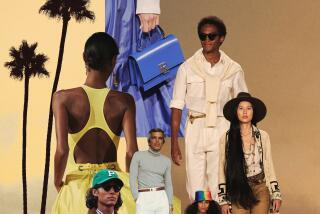It’s Back in the Black for Woolrich Inc.
- Share via
WOOLRICH, Pa. — For nearly 170 years, the Woolrich name has been equated with rugged outdoor wear: Woolrich blankets kept troops warm during the Civil War, and its outfits went with an Antarctic expedition.
Then came the competition. L.L. Bean and Eddie Bauer. Patagonia, Columbia, the North Face and Timberland.
Woolrich Inc. was running uphill to catch up with competitors, but after several years of losses, it is once again in the black.
The family-owned company in the mountains of central Pennsylvania is trying to shake its stodgy image--without sacrificing its red-and-black-checkered tradition.
Woolrich advertisements are appearing on the Discovery Channel, and in Outside and Men’s Journal. A New York design team is developing products. And in this world of L.L. Beans and Eddie Bauers, the company is pushing the Woolrich name like never before.
“It’s all about brand now,” said Woolrich President Roswell Brayton Jr., a 47-year-old Harvard University graduate. “You can’t just make a high-quality product and hope word gets out there word-of-mouth.”
It is not a matter of establishing brand recognition; the Woolrich name is especially well-known among the 40-and-older set in the Northeast, Midwest and Northwest. But the company wants to win over the 20- to 35-year-olds who pursue an outdoor lifestyle--and the folks trying to look the part.
So far, the approach seems to be working: Though it won’t disclose precise figures, the privately held company has enjoyed back-to-back years in the black after suffering through a few years of losses.
Woolrich’s conservative roots date to 1830, when John Rich founded the company to make fabric for wives of hunters, loggers and trappers. But after enjoying popularity during the camping craze of the 1970s, the outdoor-clothing industry grew crowded in the 1980s, and Woolrich suffered.
“I think the problem we were having at that time was we were a company that was built on a basic product,” said Richard Insley, vice president of merchandising. “Parkas, flannels, wool shirts, staple commodities. All the players that were building their own brands were starting to do their own instead of buying from Woolrich.”
Brayton admits, “We were being left behind.”
In 1990, the company laid off half of its 2,600 workers. Six plants in Pennsylvania, Colorado and Nebraska closed from 1990-95.
Much of that work has shifted to Mexico, where workers assemble clothing from fabric produced at Woolrich. Today, 40% of the company’s products are produced abroad, 40% are bought as finished products from other manufacturers, and 20% are assembled at Woolrich plants.
The company now employs about 1,400 people, down from 3,000 in 1988.
“We have gone from being primarily a manufacturing company to primarily a marketer and distributor,” Brayton said.
Woolrich has added 24 retail stores since 1990, and the company is considering a retail Web site and a catalog.
“Who is a retailer, who is a manufacturer, who is a distributor--those lines have become so blurred,” Brayton said. “L.L. Bean, Eddie Bauer, they used to be our customers, and they still are. But they also are our competitors because they’ve become brands.”
So have Patagonia, Columbia, the North Face and Timberland.
“When I started here 22 years ago, there were not a lot of looks available,” said Howard Solomon, outerwear buyer for I. Goldberg in Philadelphia. “They were all pretty much the same. You had your basic military pea coat, your bomber jacket, your snorkel parkas. Today outerwear styles are so broad.”
Woolrich is working to catch up with competitors that have been marketing-and-retail-oriented from the start.
“Historically, we have been a build-the-company-one-brick-at-a-time company that has not put as high a percentage of money into marketing as our competitors,” Brayton said. He knows that doesn’t work anymore. So Woolrich is making its name more visible on its clothing and trying to differentiate its traditional products from the competition’s.
Rather than producing reams of plain flannel shirts, they’ve added new designs. They are having success with Polartec fleece products. Blankets once thought of exclusively for hunting cabins are softened to make shoppers think of home.
They have also pitched their clothing to Hollywood: Disney outfitted its actors in Woolrich gear for “The Horse Whisperer.”
For all the effort to grow and change, Woolrich remains loyal to standbys, such as the Arctic parka. That jacket, long a success at home, has been a hit in Italy--keeping the two apparel plants in Pennsylvania busy.
“We had a few losing years there, and we’ve got it in the plus category now,” Insley said. “It’s been a pretty big turnaround.”
(BEGIN TEXT OF INFOBOX / INFOGRAPHIC)
169 Years in Business and Counting
Facts about 169-year-old outdoor clothing maker Woolrich Inc., a privately held family company:
* President: Roswell Brayton Jr.
* Plants: Woolrich and Jersey Shore, Pa.; Soperton, Ga.
* Employees: About 1,400, two-thirds of them in Pennsylvania
* Retail stores: Chicago, Boston and Philadelphia; outlets in 24 other locations
* High points: Builds first woolen mill (1830); produces blankets for soldiers in the Civil War (1860-64); introduces all-wool bathing suits, beach robes and golf knickers (1927-30); outfits Admiral Byrd’s Antarctic expedition (1939-41); introduces “Mad Mod Vests” in tartan wool and “Hip” fringed, plaid vests (1971); sees workforce peak at 3,000 (1988); outfits cast of Disney’s “The Horse Whisperer” (1998)
* Low points: Lays off half of its 2,600 workers (1990); closes six plants in Pennsylvania, Colorado and Nebraska (1991-95)
* Slogan: The Original Outdoor Clothing Co.
* Web site: https://www.woolrich.com
Associated Press
More to Read
Inside the business of entertainment
The Wide Shot brings you news, analysis and insights on everything from streaming wars to production — and what it all means for the future.
You may occasionally receive promotional content from the Los Angeles Times.









